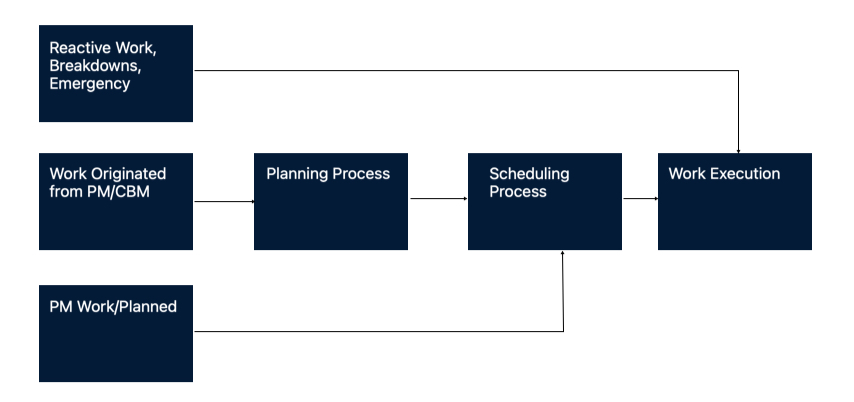Planning & Scheduling Workflow
It is easy to get overwhelmed with all incoming work order requests. Some of the requests could be planned (Preventive Maintenance), some need immediate attention due to breakdowns or emergency work (Corrective Maintenance/Unplanned), and some could result from planned activities such PM/CBM (Condition Based Maintenance). Without a proper work order management panel, it would be impossible to get all work organized and scheduled.
A typical workflow
Of course, the flow could be more complicated depending on the size of your organization and the number of assets maintained, but the core concepts should be the same.
Planning Process
Typically, all new work goes into the planning process. During the planning, the work is evaluated for the organization’s priorities, budget, and feasibility. During the planning process, the availability of all the tools and materials is checked to make sure the workers will be able to complete the work once approved. The time and cost needed to complete the project is also estimated during the planning process. Once everything is in place, the work request is moved to the scheduling.
Scheduling Process
During the scheduling, the workers’ and teams’ availability is evaluated based on the priorities and criticality of the current workload and then scheduled. Schedulers typically work with supervisors, coordinators, and other support staff to develop weekly, monthly, and rolling annual plans to execute maintenance work.
Key Roles involved in Planning & Scheduling
- Asset/Resource Coordinator
- Planner
- Scheduler
- Systems Engineer
- Supervisor
- Work Performer
Initially, the work request is routed to the coordinator. The coordinator helps to prioritize the work ensuring required resources are within the budget and schedule any asset downtime. The coordinator forwards the work to the planner/scheduler. The coordinator may also work with the maintenance engineer for any technical help.
The maintenance planner creates a work plan consisting of what needs to be done, how it will be done, what materials, tools, and skills are required. The planner also needs to identify long delivery items and order any material or tools needed to complete the work.
The maintenance scheduler works with supervisors and developers weekly, monthly, or annual plans to execute maintenance work.
The maintenance supervisors take the weekly schedule and assign individuals or teams who will do the work.
Depending on the size and type of the organization, you might have the same person performing and responsible for multiple roles.

